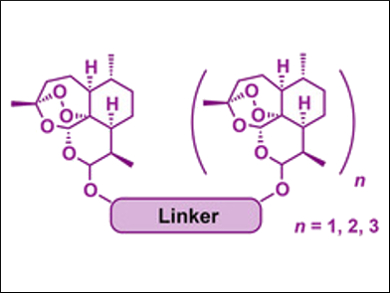Artemisinin, a sesquiterpene isolated from Artemisia annua L., is used in traditional Chinese medicine to treat malaria. Its derivatives often combine high activity with low toxicity and high selectivity. Despite the antimalarial, anticancer, and antiviral properties of these derivatives, their targets and precise mechanism of action are still not fully understood.
Manfred Marschall, Svetlana B. Tsogoeva, University of Erlangen-Nürnberg, Germany, and colleagues have prepared a series of artemisinin-based dimers, trimers (pictured), and dendrimers. The effectiveness of these compounds against malaria parasites (Plasmodium falciparum 3D7 strain) and the human cytomegalovirus (HCMV) have been investigated. The team immobilized the compounds and subjected them to mass spectrometry-based target “fishing” experiments using total lysates of HCMV-infected human foreskin fibroblasts (HFFs).
The researchers found two novel target candidates, namely cytoskeletal and mitochondrial proteins. Two compound-binding viral proteins, major capsid protein (MCP) and envelope glycoprotein pUL132, which are both essential for HCMV replication, were identified. The researchers say that these findings will facilitate studies of important cellular mechanisms and regulated molecular pathways for artemisinin-based drugs.
- Synthesis of Artemisinin-Derived Dimers, Trimers and Dendrimers: Investigation of Their Antimalarial and Antiviral Activities Including Putative Mechanisms of Action,
Tony Fröhlich, Friedrich Hahn, Lucid Belmudes, Maria Leidenberger, Oliver Friedrich, Barbara Kappes, Yohann Couté, Manfred Marschall, Svetlana B. Tsogoeva,
Chem. Eur. J. 2018, 24, 8103–8113.
https://doi.org/10.1002/chem.201800729




